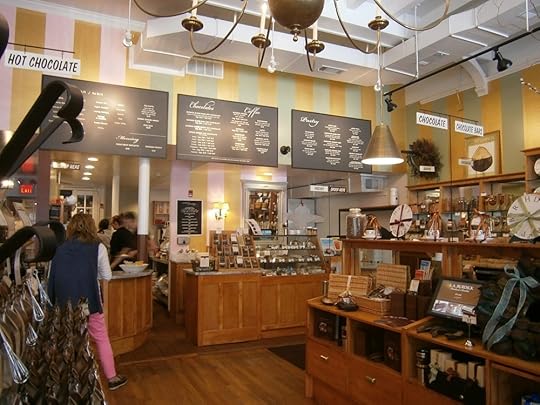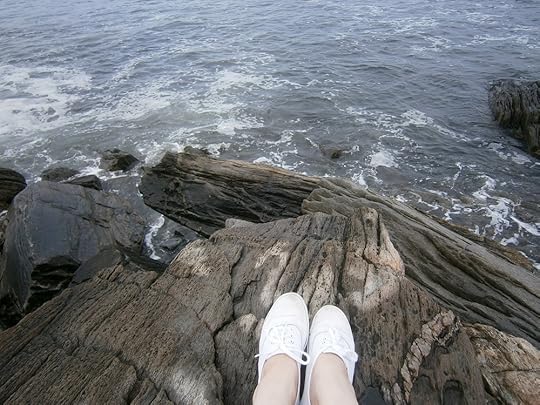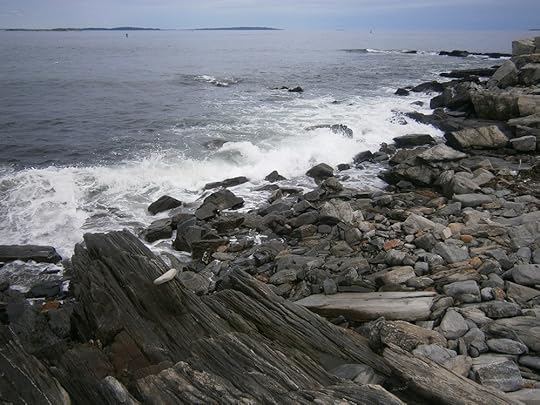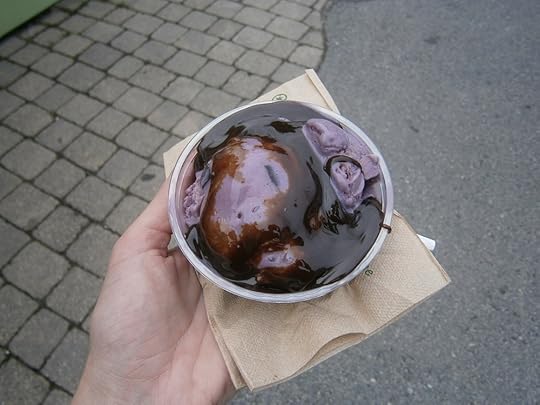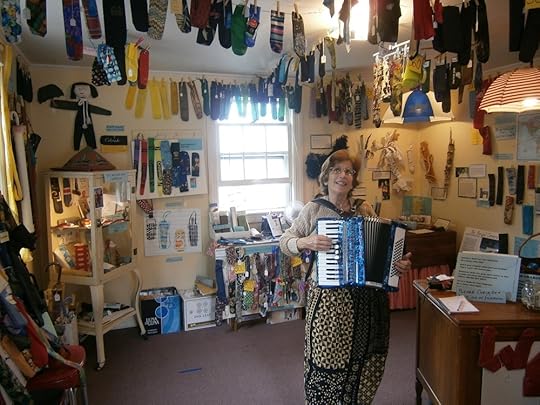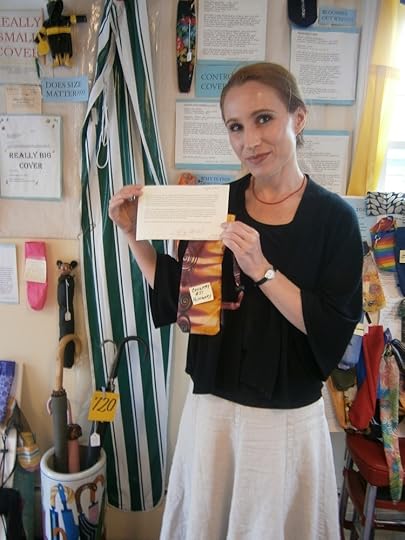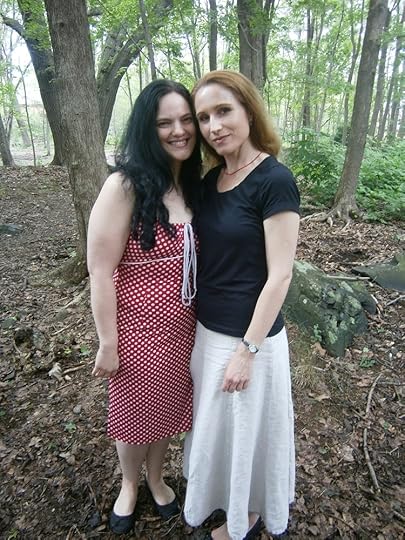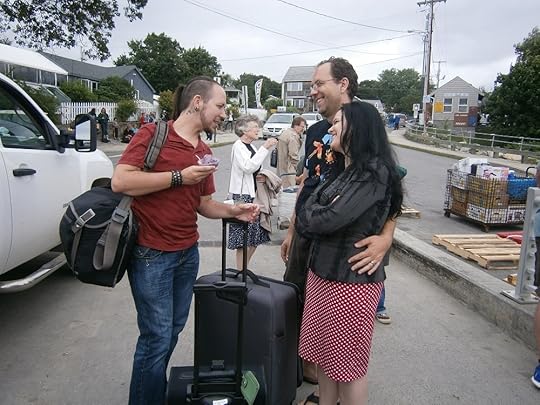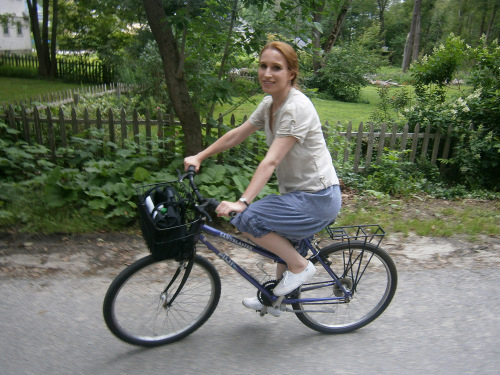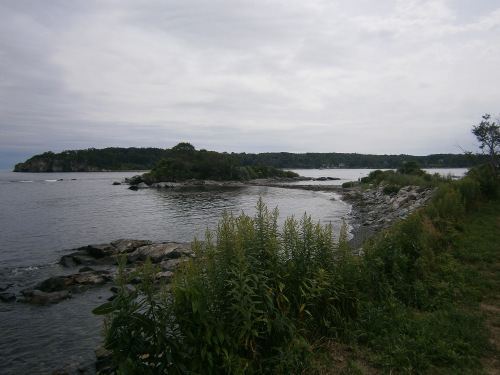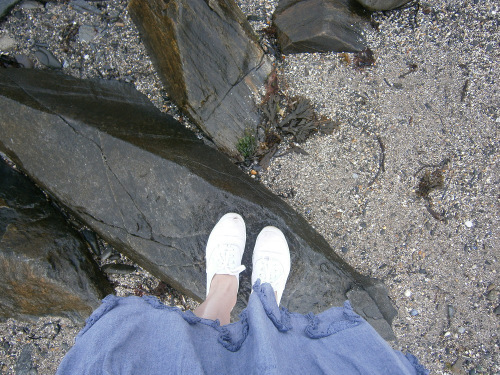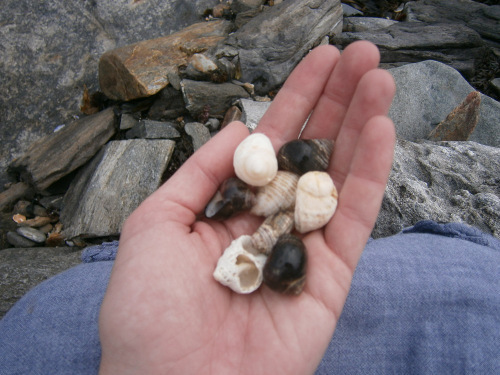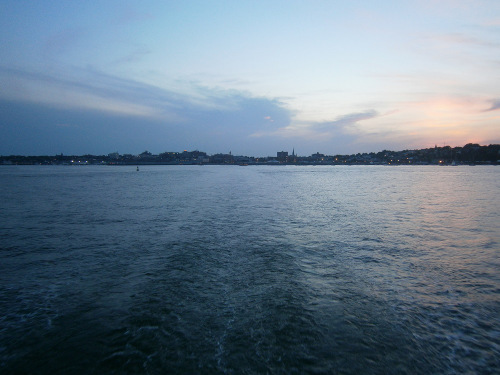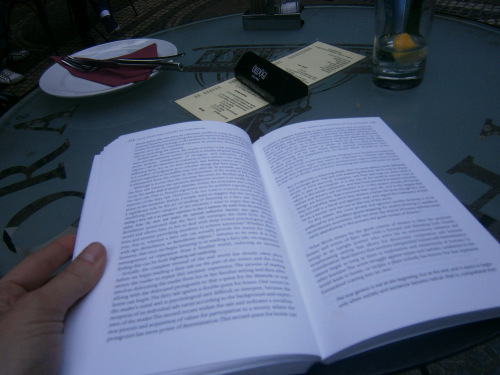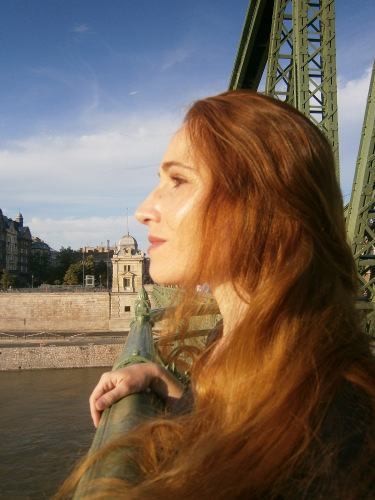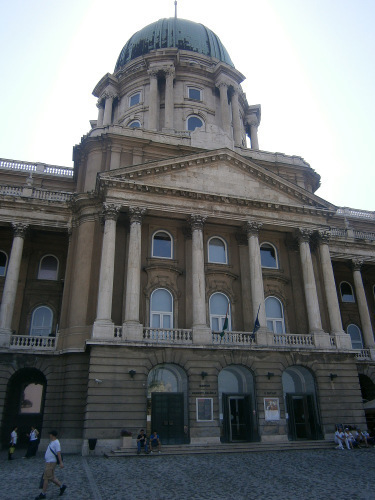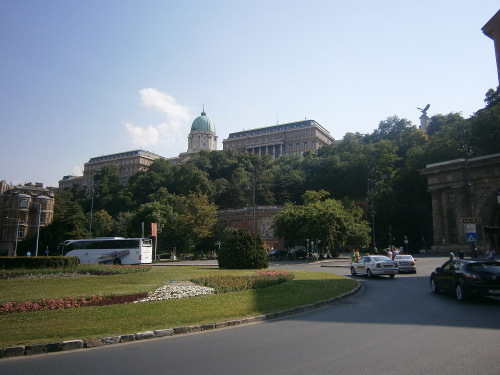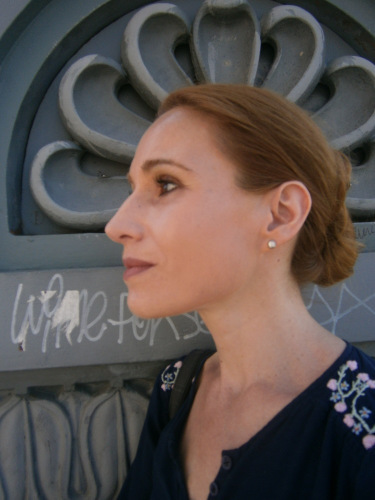Theodora Goss's Blog, page 25
August 8, 2013
Finding the Balance
The thing about being me is, I have things coming at me all the time. I know other people have lives like this too — not everyone, but certainly anyone in the arts. I was having lunch with two friends who are also writers recently, and we talked about how busy we were, all the different things we were doing. We all taught and wrote, so we had teaching deadlines as well as writing deadlines. We were all doing fascinating things — I think I’m doing fascinating things, and I’m so grateful to be able to do them. But we were all also working very hard.
So one thing I need to do, especially now that I’m back from traveling and focused on work, is find the balance. I need to make sure that I’m not burning myself up or out, that I’m doing the ordinary things I need to do, to keep myself balanced and happy. That means eating and sleeping. (Don’t laugh! There are days when eating well, and getting enough sleep, are a challenge. I sometimes need to remind myself that a cereal bar and some chocolate are not lunch.) And I need to make sure that among all the work, I do actually have fun — have a life, as well as a working life.
I’m including pictures from two things I did recently, two small outings that were fun breaks. The first was meeting a friend for chocolate at Burdick, the famous chocolate shop. Here are the interior of Burdick and what I had to eat — my favorite, the Hazelnut Orange Cake.
Finding the balance is also crucial to what my last blog post is about: managing darkness. Because it’s so easy for one’s mood to be affected by what one eats, or lack of sleep, or lack of exercise. So I’m trying to make sure that I get all the things I need to be healthy. There are so many stories of writers who were not healthy, who drank to excess for example. But productivity takes a certain measure of sanity and health. So I’m working on those things.
(And I recently discovered a way to deal with insomnia, which has been a problem for me since I was a child. It involves doing at least a half hour of pilates and then listening to a meditation CD that a friend gave me. It’s called Meditation for Busy People, and I was too busy to try it for about six months. But it’s incredibly, wonderfully relaxing.)
My second outing was downtown, where I stopped by a cart selling hats in Faneuil Hall. This is the hat I bought for myself, to keep the sun out of my eyes. Sitting at the cart was a lovely Frenchwoman who told me how to make a hat fit if it’s a little too large: put tissue paper inside the inner band. Frenchwomen know these things. (I did not need tissue paper inside the band, because my head is rather large, as you might expect! I’ve stuffed a lot of things into it.)
The first picture is of me wearing my 1950s-style Audrey Hepburn dress, because I was channeling Audrey that day. I think that’s how I ended up with a hat. It was an Audrey sort of hat . . .
Finding the balance is always hard for me. I tend to take on too much and push myself too hard, expect too much of myself. But I think I have to focus on it now, because the truth is that I can’t create good art when I’m too tired, or unhappy with the world or myself. And that’s the goal, finally, isn’t it? To create good art . . .


July 31, 2013
Managing Darkness
Last night, I dreamed that I was standing on a beach. It was a sandy beach: I could feel the sand between my toes and the sun on my arms. The sky was blue above me. I was watching the waves, a camera in my hand, ready to take pictures. And then, while I watched, one of the waves grew larger and larger. It crashed over me and swept me out to sea. Since I saw the wave growing and could anticipate what might happen, I had enough time to put my glasses and camera into my camera bag. And then the wave crashed over me. I opened my eyes and saw swirls of blue and green, the roiling water. I felt the confusing of being swept out. When I surfaced again, I was far from shore, still holding the camera bag by its strap. I was afraid that I wouldn’t get back to land, that I couldn’t do it by myself. That I wasn’t strong enough. But the sea helped me: another wave washed back to shore and carried me along with it. I made it to land again.
I woke exhausted.
Sometimes I wish I didn’t dream the way I do: vividly, intensely. I have many dreams each night, and in each one, it’s as though the dream is my life for the length of it. I’m completely in the dream. It becomes my reality. Sometimes this is wonderful, and I wish for the dream life, not wanting to wake up. Sometimes it’s terrible, because I can have dreams that are vivid yet mundane. Dreams of being lost in enormous subway systems, where I inadvertently leave my purse and all my identification on the subway. Of being trapped in falling elevators. But of course I also have dreams in which I can fly, or I am in love, or I write an entire novel. Wonderful dreams.
I thought some images from my visit to Peaks Island would be appropriate for this blog post. They are from my bike ride around the island, when I took pictures of the rocky shore. The shore in my dream was not rocky, but I was holding the same camera.
I posted about my dream on Faceook, and several people suggested that the dream represents my fear of being overwhelmed. One said that water often represents the emotions. And I think there’s truth in that: I’m afraid of being overwhelmed, in part by all my obligations and responsibilities, and there is certainly an emotional component to it. I’ve spent the last two months traveling, and the truth is that I wish I were still traveling. I don’t particularly want to be back. I loved freeing free . . .
There were entire days, entire weeks, while I was traveling, when I felt what I can only describe as wild joy. I felt it on the day I rode on a bicycle around Peaks Island. I felt the wild joy of riding through warm, salty air, of hearing the waves crashing on the rocks, of feeling the sunlight on my arms. The wild joy of movement, and the sea. Now I am back to work.
If you’ve been through depression, even once, you’re conscious of it ever after. It’s like having had any other disease that can recur. You watch for symptoms. That’s why I called this blog post “Managing Darkness.” Because the dream is a symptom, so now I need to manage my mood and responses. Now I need to be aware, to make sure I take care of myself. Because the truth is, I don’t want to be back here yet. I miss traveling . . .
I might write more about that, about how one manages the darkness, in my next blog post. But I think it means something, too, that a wave swept me back. That the sea took me out, but then helped me back to shore. That it returned me, safely, to land.


July 29, 2013
The Best Revenge
You probably don’t think of me as a particularly vengeful person, but there have been times when I’ve felt vengeful! It doesn’t happen often, and I have to admit that at the moment, there are only two people in the world I feel vengeful toward. Two people out of seven billion isn’t that bad, right?
I think that I’m usually a relatively nice person, but there are times when I get angry, or envious — or even vengeful. By vengeful, I don’t mean that I would wish actual harm on anyone, because that wouldn’t be nice. No, what I wish is that the universe would give the gentlemen in question (yes, they are both men) a good talking-to. Something like this: “You have been rude beyond the call of rudeness, and I suggest that you stop. Because karma.”
(In both cases, it’s for exactly the same reason: a male friend, about whom I cared very much, for whom I was there during various travails, says the following: “I am romantically involved with X, so we can no longer be friends.” To which I respond, “What? Wait, why?” To which the reply is silence. That’s rude beyond the call of rudeness, right? Anyway, I think it is. And it’s ultimately very silly, because any romantic relationship that does not allow you to maintain your friendships is going to be unpleasant. Relationships without trust usually are.)
But this blog post isn’t about feeling vengeful. It’s about revenge, the best revenge. I’m going to tell you how to get it. There are basically two steps.
1. Live a fabulous life. This step is absolutely crucial. When you feel vengeful, ask yourself, am I doing something fabulous? And if you’re not, go do something! It doesn’t have to be something extravagant. It can involve getting ice cream, or buying flowers, or walking by a river.
2. Write about it. Or take pictures! Share that fabulous life, share your story. The purpose of sharing your life is not to make anyone else envious, but to allow other people to participate in it. And of course you should participate in their stories and lives as well . . . I love it when my friends are living fabulous lives too. (But Step 1 is absolutely crucial: the point is not to post pictures, but to actually have a fabulous life. The pictures come afterward.)
This is a very satisfying way of getting revenge, which has the additional benefit that you get ice cream, or flowers, or a walk by the river — or you get to visit fabulous places. Or buy cocktail dresses! (I bought two cocktail dresses just yesterday, for $10 each at a thrift store. Now I need to find two cocktail parties . . .)
I’m going to post some pictures of the fabulous things I did on my last day on Peaks Island. First, I had some ice cream (blackberry chip with fudge topping). I walked along the main street, eating my ice cream, looking at Casco Bay and all the beautiful houses.
Then I went to the Umbrella Cover Museum (which does actually exist). This is a picture of the proprietor, Nancy 3, playing her accordion for visitors. You can see all the umbrella covers she has collected.
In the Umbrella Cover Museum, there was a very special cover, with a story. The cover is the one Catherynne Valente brought back after spending several weeks in Budapest with me last summer. Nancy 3 took a picture of me with the cover and the story Cat had written describing where it came from.
Then it was time for me to leave, but before I did, Cat and I posed for a picture together. (There, by the way, is a woman with a fabulous life! It was such a privilege to visit her on Peaks Island.)
Here are the people I stayed with that week, saying goodbye on the ferry landing: Cat, Dmitri Zagidulin, and fellow guest Lee Harrington (who got the same flavor ice cream I had been eating earlier). I was sad to leave, but it was time to go home, where other adventures were waiting for me.
So there you go, that’s the best revenge: having a fabulous life and then getting to talk about it, share pictures — and be part of the fabulous lives of other people.
If you’re ever feeling particularly vengeful, and I mean deeply, angrily vengeful, you can go look at the Facebook page of the person you’re angry with and see if he’s living a fabulous life yet. Not yet? Nope, not yet. Because karma. But then? Go back to living your own fabulous life. Because ice cream, and riding bicycles around islands in Maine, and going to cocktail parties in fabulous dresses that only cost $10. And having fabulous friends. You might actually forget, for a while, about taking revenge . . . And if you remember, there’s always Facebook!


July 26, 2013
Being the Adventure
This past week, I was in Brunswick, Maine, teaching at the Stonecoast MFA Program summer residency. Then I went to Portland, and then to Peaks Island in Casco Bay, so I could visit one of my favorite people, fantasy writer Catherynne Valente. While I was there, one of the Stonecoast students posted what I thought was an interesting and important Facebook update: she said that after the intensity of the residency, it was difficult returning to ordinary life. And I completely understand that.
How do we do that, after having an adventure? How do we return to ordinary life?
I have an answer, but I’m afraid it’s one that may disappoint you. My answer is: don’t. Create a life that isn’t ordinary.
Oh, I know it’s difficult. It’s particularly difficult when you’re just starting out as a young writer. You may have a life filled with obligations. Financial obligations, obligations to family. But you can start small? That’s why I titled this blog post “being the adventure.” Because when you can’t have an adventure, when you have to grade papers or care for a child, you can still be the adventure. You can still find the adventure in what may not initially seem adventurous. You can create adventure, wherever you are.
On Peaks Island, I had a wonderful adventure, although it was a very simple one. I rented a bicycle and rode all the way around the island. Here is a picture of me on the purple bicycle I rented:
(Thank you for taking this picture, Dmitri Zagidulin!)
The island is four miles around, so it was not very difficult to bike all around it. But I saw the most beautiful things. A small island connected to the larger one by a causeway, where I later clambered among rocks covered with bright yellow seaweed, and smelled the last of the rosa rugosa, and collected shells. A stony beach where people had piled stones on top of each other to form sculptures. Miles of road by the sea, where I rode to the crashing of waves and said hello to everyone I passed. Houses painted pink and blue and yellow, surrounded by gardens filled with the sorts of flowers that grow in a moist, cold climate.
Here is the island connected by the causeway:
And here is me clambering on the rocks, wearing my beaten-up Keds with a hole in the toe:
And here are the rocks with the bright yellow seaweed:
And here are the shells:
After my ride, I bought myself ice cream in the shop by the ferry landing. I didn’t want to return my bike, although of course I had to, eventually. But for three hours, I had felt so free, so happy. Now, I know that not everyone can go to an island in Maine. And tonight, I’m going home to Boston on the train (which is where I’m writing this blog post, moving through the night, somewhere between Portland and Boston). I suppose you could say that I’m finally returning to ordinary life, but am I? In Boston, I will have a month to finish a novel before the semester starts. So I’ll be finishing the draft of my first novel, which surely isn’t an ordinary thing to do. And I’ll be hunting for summer skirts at my favorite thrift stores, and walking around the city, and visiting the river, and going to the art museum. I’ve been so many places this summer, but I’m not returning to the ordinary, because my life isn’t ordinary — I have imagination, and so anything can be an adventure. I’m the one who brings the adventure to it.
I once wrote, “some people don’t have adventures, some people have adventures, and some people are adventures.” I am the adventure: all of the things I do could be ordinary, but my imagination transforms them. Finding a summer skirt becomes finding a magical garment. Ice cream (with fudge topping!) becomes a fairy feast. (Well, the right kind of ice cream is a fairy feast!) You can do that to anything, even — yes, even housekeeping. Think about how often housekeeping comes up in fairy tales, after all.
I want my life to be a great adventure, but I know that I’m responsible for turning it into one, for being adventurous — because that’s how it works. It’s my responsibility to be the adventure . . .


July 23, 2013
Living Our Metaphors
“I haven’t a clue as to how my story will end. But that’s all right. When you set out on a journey and night covers the road, you don’t conclude that the road has vanished. And how else could we discover the stars?” —Nancy Willard
I found this quotation at the top of a terrific blog post by Justine Musk: “the epic feminine: welcome to the epic story of your life (+ how to make it a good one).” It made me think about how we tend to live out our metaphors.
Once, a friend of mine told me that she had started running. She was running a lot, probably too much — eventually, she would train for a marathon. At the same time, she was in a relationship in which she was desperately unhappy (it would later end). I asked her, “What are you running from, or to?” Running was a metaphor: she wanted to get away from the relationship, get to something else. But she couldn’t, at least not at that particular moment. So she started running. When we look at our lives, we often find that we behave in metaphorical ways. If we can read these behaviors, as though they were texts (metaphors in words), we can understand what we truly want, or don’t want.
I’m thinking about this because I’ve been doing a lot of traveling this summer. And the question is, how do I read that action metaphorically? What does it tell me about myself?
Tonight, I’m writing this in a house on Peaks Island, Maine. I’m staying with the wonderful Catherynne Valente, who lives here (and travels a lot herself). I arrived yesterday, and it was an adventure getting here. I’d been in Brunswick, Maine, teaching at the Stonecoast MFA Program, so the first step was taking the train to Portland. Then I took a taxi to the ferry station, which looks like this (from on board the ferry).
And then we set out across Casco Bay, to the island. Here is Portland, with the sun setting over it, from the back of the ferry.
And here is me on the ferry, heading toward the island. Heading into the darkness. It was a windy night, and my hair was everywhere.
I think I’ve been traveling so much because I don’t know where I’m going. Traveling in space becomes a way of thinking about traveling in time. I’m living out the metaphor. Perhaps by doing so, I’ll come to a better understanding of my life.
I haven’t a clue as to how the story will end. I’m a character in it, not the author of this particular narrative. Which, to be honest, is difficult sometimes — I wish I could skip ahead to a later chapter, make sure our protagonist is still all right. Make sure that, if she hasn’t gotten her happy ending yet, she’s headed there, or has at least learned something worthwhile along the way. And yes, sometimes it’s night and I wonder if the road has vanished, or if there was no road in the first place — if I imagined the road. (But perhaps I’m in a ferry, moving across the water?) However, we can’t know our own stories before they happen.
All we can do is trust them, and try to understand how we are living them. Try to read our own metaphors . . .


July 15, 2013
The Question
If you follow this blog at all, or follow me on Facebook or Twitter, you know that I have a corkboard over my desk. On it, I have several stickies on which I’ve written quotations that I want to remember. Here are a couple of them:
If you ever find yourself in the wrong story, leave. –Mo Williems
Do what I do: hold tight and pretend it’s a plan. –The Doctor
What would you do if you weren’t afraid?
(I don’t know who said that last one, but I know I read it on Terri Windling’s blog.)
I’m thinking of addinga sticky to the corkboard, but what I want to write on it is such a self-help cliché that I’m hesitating. Which is silly. What I want to write is a question, and it’s an important question for me to remember, because it’s one I should be asking frequently. Here it is:
Am I loving myself?
Love is both a noun and a verb: it’s both an emotion and an action. To love someone means not just to feel love for them but to act lovingly toward them. The act itself is a manifestation of love. So when I ask, am I loving myself, I’m not just asking how I feel about myself. I’m asking how I’m treating myself, whether it’s with love.
Obviously, the answer is often no . . .
Often, I don’t in fact treat myself particularly well. I get mad at myself and tell myself all the ways in which I’ve failed, or I’m inadequate. I don’t give myself the things I need: time to rest or take long walks, nourishing food. I push myself too hard. I blame myself for not giving other people what they need or want, even when it’s not possible or would involve significant sacrifice. Or I just make the sacrifice. (Is this a familiar list? I bet you’re nodding.)
What I need to do is treat myself as though I were in a relationship with myself. (In a sense, I am.) I need to take myself out, give myself treats, show myself that I care. Make sure that I’m taken care of. I’m not always so good at this . . .
That may seem selfish in that it’s self-ish, about the self, having to do with the self. But I think if we don’t love ourselves first, we end up not loving other people particularly well either. We start to resent them, because we know that we are missing something. We may expect them to supply that thing, but you should never depend on another person to supply the love that you aren’t giving yourself. That’s your job, not theirs.
So the question is there to remind me: I’m not going to useful, or productive, or loving, unless I love myself. And that’s an action, or rather the action is as important as the emotion. In fact, the emotion doesn’t need to be there for me to take action. Even when I don’t feel love for myself, I can act lovingly toward myself. I can buy myself flowers, take myself on a long walk, give myself time to rest. And then, often, the emotion will come — I will remember that I do love myself, despite how much trouble I can be sometimes.
I thought I would include two photographs in this blog post. The first is of me with the students at the Alpha Science Fiction, Fantasy, and Horror Workshop for Young Writers, where I was teaching last week. I had such a wonderful time at Alpha!
The second photo is of me with two lovely friends of mine, Nancy Hightower and Valya Dudycz Lupescu. This was taken at Readercon, the convention I attended last weekend.
I’m including them because loving myself also includes doing what I love: teaching wonderful students like those at Alpha, and spending time with my wonderful friends. Those are gifts I give myself, like buying myself flowers.


July 7, 2013
Self-Reliance
Yeah, I know. Ralph Waldo Emerson wrote an essay called “Self-Reliance,” and I’m not exactly going to top that, am I? Anyway, I’m not trying to rise to his level eloquence. This for example:
“A man should learn to detect and watch that gleam of light which flashes across his mind from within, more than the lustre of the firmament of bards and sages. Yet he dismisses without notice his thought, because it is his. In every work of genius we recognize our own rejected thoughts: they come back to us with a certain alienated majesty. Great works of art have no more affecting lesson for us than this. They teach us to abide by our spontaneous impression with good-humored inflexibility then most when the whole cry of voices is on the other side. Else, to-morrow a stranger will say with masterly good sense precisely what we have thought and felt all the time, and we shall be forced to take with shame our own opinion from another.”
Yeah, I’m not competing with Ralph . . .
Anyway, this is about a particularly small and local kind of self-reliance: the kind that allows you to visit a museum by yourself, or eat dinner by yourself in a restaurant. I’m writing about it because I know a lot of people who don’t feel comfortable doing those things. Either they don’t feel comfortable being alone or they don’t feel comfortable having other people see that they’re alone. Those are two different things, of course — and I’ve met people who fall into both categories.
I thought I would include some pictures of me eating dinner on my last evening in Budapest, all by myself at my favorite restaurant. Here is the courtyard of the restaurant:
I can only speak for myself of course (Ralph would probably agree with that), but I value my solitude. I love spending time with people, but if I don’t get time to spend with myself, by myself — I become quite cranky. It’s part of being an introvert, I suppose. I love to travel by myself, and one benefit of doing so is that I get to see what I want, to think my own thoughts about it rather than having to tell other people what I’m thinking or having them continually tell me what they’re thinking. My favorite hosts and guides are the ones who simply let me do what I want, and I try to be that sort of host or guide myself, when people are visiting.
So, while I love people, I also love spending time alone. I suppose that’s one reason I feel so comfortable going to a museum by myself, or sitting in a restaurant by myself. But also, I always seem to meet people that way . . .
This is the book I was reading in the restaurant: Jack Zipes’ Fairy Tales and the Art of Subversion. So I suppose, really, I wasn’t alone. I had the cantankerous, opinionated Zipes with me, and I had my favorite waiter to talk to, and I was surrounded by people speaking in English and Hungarian. It was lovely to sit and experience all that, without distractions.
The other reason people feel uncomfortable being alone has nothing to do with missing other people — they would feel perfectly comfortable being alone in their houses, as long as no one could see them. It’s that being alone is accompanied by a sense of shame. It’s as though being alone implies they have no friends, that they couldn’t find anyone to go with them. They are self-conscious. And I understand that — our culture emphasizes extroversion, the importance of being social and having friends. I guess the thing is, when I’m doing something alone, I never feel a sense of shame — I always have a conviction that I’m being fascinating and adventurous. Surely anyone who notices me is thinking, who is that woman sitting by herself? What is she reading? She looks so chic and sophisticated, all by herself . . . At least, that’s my conviction. But, probably more accurately, I suspect that no one notices or cares. That no one is judging me — everyone around me is simply going on with their lives.
It seems silly, to be ashamed of being alone . . .
This, by the way, is what I had at that final dinner: Hortobágyi Húsos Palacsinta. It’s one of my favorite dishes in the whole wide world, but you can only really get it in Hungary.
It’s important, at least for me, to be self-reliant. To be able to travel by myself, go into a foreign city with a map and walk around. To figure out exchange rates, visit the museums. Go to restaurants. Ask for help if I need to, laugh when I mess up.
And to be alone. I love my friends, who are wonderful. But I also need my alone time; I also need to wander around a city all by myself, looking into shop windows, browsing the bookstores, thinking my own thoughts . . .
I’ll send with something Ralph said, because he’s good people, is Ralph:
“Trust thyself: every heart vibrates to that iron string. Accept the place the divine providence has found for you, the society of your contemporaries, the connection of events. Great men have always done so, and confided themselves childlike to the genius of their age, betraying their perception that the absolutely trustworthy was seated at their heart, working through their hands, predominating in all their being. And we are now men, and must accept in the highest mind the same transcendent destiny; and not minors and invalids in a protected corner, not cowards fleeing before a revolution, but guides, redeemers, and benefactors, obeying the Almighty effort, and advancing on Chaos and the Dark.”


July 5, 2013
An Adventuress
I want to be an adventuress.
But that term has been used in some pejorative ways, so I have to specify what I mean by it. What I mean is a female adventurer. You know, like those Victorian women who went to distant lands, and learned the local languages, and climbed the Himalayas — often in not very practical Victorian clothing. Why then don’t I simply use the term adventurer? I suppose because it doesn’t have the same feel to it, the same sense of breaking boundaries and doing it with a sort of style and grace. I want some of the connotations of the word. But not others, because the term often describes women who use their charms and wiles to live off men — and that’s the opposite of adventure. An adventure requires self-reliance, guts. An adventure involves discovering yourself.
This was the conclusion I came to, that I wanted to be an adventuress, after returning from Europe. Which happened yesterday, actually. Yesterday morning I was in Budapest, and today I am in Boston. This is the last picture of myself that I took in Hungary, leaning against the railing of the Szabadság híd (Liberty Bridge), looking at the Danube. It was almost sunset: Budapest has the most gorgeous light at sunset.
What I learned, being in Europe for two months, was how easily I moved around, how much I loved the act of traveling. Of looking out a train window. Of getting into an airplane and flying to another country. Of carrying adapters, and trying to figure out new plumbing arrangements, and making my way in another language. Did you know that in England, there are no electrical outlets in bathrooms? It’s illegal, so you have to go into another room to dry your hair. Also, all over Europe, it’s useful to know the term “to take away,” which is equivalent to the American “to go,” because you are charged more for food that you’re going to eat in.
I like going to museums and seeing original paintings for myself: Renaissance art, for example, looks completely different for real than it does reproduced. It’s only when you see it for real, and up close, that you realize its complete brilliance. In Brussels, I saw Landscape with the Fall of Icarus by Pieter Bruegel (at least we think it’s by him, but maybe not say the art scholars). I had the impulse to bow before it, as though I were meeting an important personage . . . I like figuring out maps and metro systems, walking through a strange city and seeing the architecture, coming upon small cafés and bookshops. In Budapest I found an English bookshop and bought too many books. In Brussels I came across an outdoor antiques market and bought some English transferware coffee cups. Ever after, I can look at those things and say, yes, I found that copy of Margaret Atwood’s Alia Grace in Budapest. Or I brought those cups all the way back from Brussels.
There are good and bad things about being an adventuress. It means that I’m not very good at living a quiet life. I need to be doing things, going places, and there’s a sort of restlessness in that: I always feel as though I should find contentment in simply being. But that’s not who I am, and I think it’s better to accept that about myself than fight against it. I want a life of adventures and new experiences — sometimes those are uncomfortable and inconvenient, sometimes they can even be frightening. I don’t like inconveniences any more than the next person, and I try to avoid dangers. But the lure of adventures, of new things, even the smallest — of using different kinds of money, eating different kinds of foods! That is a great and powerful lure.
I think I’ll add one more picture, also of myself looking at the Danube that final evening. It was hot and I had put my hair up — I twist and tuck it, and it stays up by itself. But the bridge was windy, and the wind blew my hair down, so I ended up with this. I’m ending with it because I think it makes a fine Portrait of an Adventuress.


June 24, 2013
Grand Narratives
When I was in London, I had a long talk with a friend of mine who said something that struck me. He said that in his life, he wanted a “grand narrative.” And he had gotten one: he’s a musician, composer, and rock star. He had decided on things he wanted to do in his life, and he had done them, and they did in fact create a grand narrative — a fascinating story. His biography would be a terrific read.
I think many, perhaps most, people don’t want a grand narrative. I’ve known many that do, but then I spend my time with writers and artists, and they are more likely to want their lives to be fascinating stories. They are more likely to want grand narratives. (Although many of them don’t want grand narratives either — they simply want to do the work, and have the work speak for them.)
It seems almost vain or frivolous to want a grand narrative for one’s life — as though one should be satisfied with the work, and with a measure of security that allows one to do the work. And yet, it’s hard not to want a fascinating biography, a life in which unexpected things happen. At least, I find it hard not to want that, and after all, here I am writing this post at a coffee shop in Budapest. That’s pretty dramatic, isn’t it? And here I am telling stories about my life, on this blog, and Facebook, and even Twitter.
The pictures I’m going to include in this post are from the Hungarian National Gallery, the art museum I visited yesterday. Here is the art museum, which is housed in the castle on Castle Hill.
Pretty dramatic, isn’t it? I think it’s hard not to want a certain amount of drama and excitement in our lives. And to be honest, what I’ve noticed is that the people who want it, who want the grand narrative, tend to get it. They do in fact tend to have dramatic lives, the sorts of lives that would make good biographies. I suppose that to a certain extent, we all get what we want, what we expect for yourselves, because that’s what we work for. (Not completely, of course, which is why I qualified that statement. But our expectations do seem to determine our possibilities, at least in that what we don’t want or believe we can have, we usually don’t try for.)
This is the castle from below, when you’ve climbed down the hill and are ready to cross the Chain Bridge.
And this is the Chain Bridge, which is also pretty dramatic, with all its lions. I think every bridge needs lions, don’t you? Lots of lions, as many lions as possible and as good taste will allow. We all need lions to add drama to our lives.
And finally, here is me on the Chain Bridge, in front a beautiful design and some graffiti. That’s so Budpest: the Art Nouveau decoration and the graffiti both.
Many of my favorite writers and artists did have grand narratives. Isak Dinesen, Virginia Woolf, Georgia O’Keefe . . . They did not necessarily have happy lives, and the problem with grand narratives is that they’re not always happy. I’d like to have the grand narrative and the happiness both. But I understand what my friend meant by wanting a grand narrative. I want one of my own, and I think I’m doing a pretty good job of creating one — well, as much as I can. And then, I also want to do the good work . . .


June 23, 2013
The Art Museum
I grew up going to art museums. My mother always took me, although we have very different tastes in art: she likes modern art, by which I mean late 20th century. I like art of the 19th and early 20th centuries. When I was old enough, I would go into Washington D.C., where I lived as a teenager, and spend the afternoon at the art museums. Luckily, in D.C. all the museums are free, or I could never have afforded to go . . .
Whichever city I’m in, I always go to the art museums. In Boston, I’m a member of the Museum of Fine Arts, and here in Budapest, I knew that I wanted to go to the large, official art museum, the Hungarian National Gallery, before I left. I hadn’t been in a long time, because when I’m here I’m often with friends, and we go see the more touristy things. Not the art. But yesterday, I finally had time to go, and so I went.
The Hungarian National Gallery is in the castle at the top of Castle Hill. That means it’s an all-day trip, because I have to get up the hill, and then see the art in the museum, and then get back down the hill. That takes several hours. Yesterday was a perfect Saturday for it, except for the heat. But at least it was cool in the museum . . . This art museum is different from most of the large official art museums I visit, because it focuses specifically on Hungarian art. There’s no effort to include a token Picasso or Matisse for example, as you find in so many other art museums, and certainly in the American ones. I like that: it means you get to see all the art movements as they filtered through one particular country. I have a favorite Hungarian artist, and I’ll include three of his paintings here, each of which I saw in the museum yesterday. His name is Pál Szinyei Merse (1845–1920).
This is a painting called The Skylark:
I loved seeing the history of art through this particular national lens. It was particularly interesting to see late 18th and 19th century academic art applied to Hungarian subjects: incidents from Hungarian history, village celebrations, famous Hungarian beauties of their day. It was a lovely change from seeing the same techniques applied to English, French, or Italian subjects, which is what I’m used to.
What the museum made clear to me is the richness of the Hungarian artistic tradition, from the middle ages up to World War II. The period of the Hungarian Secession, which was the name given to the Hungarian version of Art Nouveau, was particularly inventive and original. It was a uniquely Hungarian interpretation of an international art movement, and you can see its effects in the architecture of the city, all over Budapest. That was in the late 19th and early 20th centuries — my favorite period, of course. And then, World War II happened.
This painting is called Faun and Nymph:
Judging from the art in the museum, World War II was devastating for Hungarian art. To my eye at least, Hungarian art after World War II, at least as represented in the museum, was entirely imitative. I found it interesting that even in the museum’s collection, World War II formed a dividing line in terms of art history: 20th century art to 1945 was displayed separately from 20th century art after 1945. And the art after 1945, to the 1980s — I’m not entirely sure how to describe it, except that although I don’t love the abstract expressionists, I do admire their innovation and power. But I’m used to looking at the spectacular American examples in the Boston Museum of Fine Arts, or in the museums in New York. These paintings were abstract expressionism without its power. And they did not seem particularly Hungarian anymore.
And here is The Balloon:
I am, of course, open to being told that I’m wrong, that important art was happening in Hungary during that period. That I just didn’t look closely enough, or that it isn’t represented in the museum collection. I would be interested to hear a contrary opinion.
I don’t have any particular words of wisdom to end this blog post, except ones I’ve written before: that it’s so important, for writers particularly, to go to museums, to see art. No matter how small the museum, you always learn something. You always take something away with you, like a gift . . .



